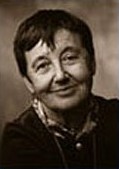Denise Schmandt-Besserat: Difference between revisions
Floydwilde (talk | contribs) →External links: Interview with Denise Schmandt-Besserat |
|||
| Line 49: | Line 49: | ||
* [http://en.finaly.org/index.php/The_emergence_of_recording The Emergence of Recording] |
* [http://en.finaly.org/index.php/The_emergence_of_recording The Emergence of Recording] |
||
* [https://drive.google.com/file/d/0B44rdVPwXrNxWkF6Q1JWUXQyWDA/view?usp=sharing How Writing Came About] |
* [https://drive.google.com/file/d/0B44rdVPwXrNxWkF6Q1JWUXQyWDA/view?usp=sharing How Writing Came About] |
||
* [http://figureground.org/interview-with-denise-schmandt-besserat/ Interview with Denise Schmandt-Besserat] |
|||
{{Authority control}} |
{{Authority control}} |
||
Revision as of 01:13, 13 February 2016

Denise Schmandt-Besserat (born August 10, 1933) is a French-American archaeologist and retired professor of art and archaeology of the ancient Near East.
Education
Schmandt-Besserat was trained at the École du Louvre.
Career
Schmandt-Besserat has worked on the origin of writing and counting,[1] and the nature of information management systems in oral societies. Her publications on these subjects include:
- Before Writing (2 vols), University of Texas Press 1992;
- How Writing Came About, University of Texas Press 1996;
- The History of Counting, Morrow Jr. 1999;
- When Writing Met Art (University of Texas Press, 2007); and
- numerous articles in major scholarly and popular journals among them Science, Scientific American, Archaeology, American Journal of Archaeology, and Archaeology Odyssey.
Her work has been widely reported in the public media (Scientific American, Time, Life, New York Times, The Washington Post, Los Angeles Times, Christian Science Monitor.) She was featured in several television programs such as Out of the Past (Discovery Channel), Discover (Disney Channel); The Nature of Things (CBC), Search for Solutions (PBS), and Tell the Truth (NBC).
She retired in 2004 as Professor of Art and Middle Eastern Studies at the University of Texas at Austin.
In her most recent book, When Writing Met Art (2007), Schmandt-Besserat investigated the impact of literacy on visual art. She showed that, before writing, art of the ancient Near East mostly consisted of repetitive motifs. But, after writing, conventions of the Mesopotamian script, such as the semantic use of form, size, order and placement of signs on a tablet was applied to images resulting in complex visual narratives. She also shows how, reciprocally, art played a crucial role in the evolution of writing from a mere accounting system to literature when funerary and votive inscriptions started to be featured on art monuments.
Schmandt-Besserat's present interest is the cognitive aspects of the token system that functioned as an extension of the human brain to collect, manipulate, store and retrieve data. She studies how processing an increasing volume of data over thousands of years brought people to think in greater abstraction. She also continues her research on Neolithic symbolism at the site of 'Ain Ghazal, near Amman, Jordan.[2]
Awards and honors
Schmandt-Besserat has received the Walter J. Ong Award for Career Achievement; the Holloway teaching award; the Eugene Kayden Press Book Award and the Hamilton book Award. She been cited Outstanding Woman in the Humanities by the American Association of University Women.
Her book, How Writing Came About, was listed by American Scientist as one of the 100 books that shaped science in the 20th century.[3]
She is listed in Who's Who in America.
At the 180th Commencement of Kenyon College she received an honorary degree.
See also
History of writing ancient numbers
References
- ^ Rudgley, Richard (2000). The Lost Civilizations of the Stone Age. New York: Simon & Schuster. pp. 48–57.
- ^ 'Ain Ghazal Excavation Reports, Vol. 1 Symbols at 'Ain Ghazal
- ^ Philip Morrison, Phylis Morrison (Nov–Dec 1999). "100 or so Books that shaped a Century of Science". American Scientist.
{{cite journal}}: CS1 maint: year (link)
External links
- Denise Schmandt-Besserat Home page at the University of Texas at Austin
- 'Ain Ghazal. Hosted by MENIC, The Middle East Network Information Center, a public service of The Center for Middle Eastern Studies at the University of Texas at Austin.
- Signs of Life. Archaeology Odyssey magazine, January/February 2002.
- Research Impact: 1, 2, 3 leads to A, B, C
- The Case of the Missing Vase
- The origins of writing and numbers: uncovered
- The Numerals Project, hosted by Linguistics Research Center, The University of Texas at Austin.
- The Earliest Precursor of Writing
- Two Precursors of Writing: Plain and Complex Tokens
- Reckoning Before Writing
- The Emergence of Recording
- How Writing Came About
- Interview with Denise Schmandt-Besserat
